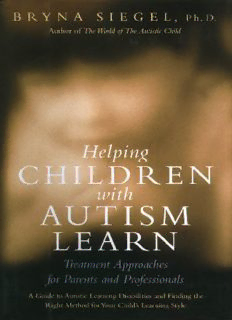
Helping Children with Autism Learn: Treatment Approaches for Parents and Professionals PDF
Preview Helping Children with Autism Learn: Treatment Approaches for Parents and Professionals
Helping Children with Autism Learn This page intentionally left blank Helping Children with Autism Learn TREATMENT APPROACHES FOR PARENTS AND PROFESSIONALS Bryna Siegel, Ph.D. OXFORD UNIVERSITY PRESS 2003 OXFORD UNIVERSITY PRESS Oxford New York Auckland Bangkok Buenos Aires Cape Town Chennai Dar es Salaam Delhi Hong Kong Istanbul Karachi Kolkata Kuala Lumpur Madrid Melbourne Mexico City Mumbai Nairobi Sao Paulo Shanghai Taipei Tokyo Toronto Copyright © 2003 by Oxford University Press, Inc. Published by Oxford University Press, Inc. 198 Madison Avenue, New York, New York 10016 www.oup.com Oxford is a registered trademark of Oxford University Press All rights reserved. No part of this publication may be reproduced, stored in a retrieval system, or transmitted, in any form or by any means, electronic, mechanical, photocopying, recording, or otherwise, without the prior permission of Oxford University Press. Siegel, Bryna. Helping children with autism learn : treatment approaches for parents and professionals/ Bryna Siegel. p. cm. Includes bibliographical references and index. ISBN 0-19-513811-2 (hardcover : alk. paper) 1. Autistic children—Education. 2. Learning disabilities—Treatment. 3. Communicative disorders in children—Treatment. I. Title. LC4717 .S54 2003 371.94—dc21 2002151673 ISBN 0-19-513811-2 3 5 7 9 8 6 4 Book design by planettheo.com Printed in the United States of America on acid-free paper To My Beginning: My Mother To My Foundation: David And for thosefor Whom I do My Work: All the Families of Children with Autism This page intentionally left blank CONTENTS Acknowledgements ix Foreword xi Introduction 1 PART I The Fundamentals of Autistic Learning Styles 11 CHAPTER ON E Understanding the Origins of Autism and Its Meaning for Development 13 CHAPTE R TW O When Atypical Development and Typical Development Cross Paths 41 CHAPTE R THREE Autistic Learning Disabilities Defined: How Strengths Compensate for Weaknesses and Form Autism 77 PART II Autistic Learning Disabilities and Autistic Learning Styles: What Makes the World of the Autistic Child Different?.... 103 CHAPTER FOUR Social Autistic Learning Disabilities: Description and Treatment 105 CHAPTE R FIVE Autistic Learning Disabilities of Communication 149 CHAPTE R SI X Autistic Learning Disabilities of Communication: Treatments for the Pre-Verbal and Non-Verbal Child 177 CHAPTER SEVE N Autistic Learning Disabilities of Communication: Treatments for the Verbal Child 207 CHAPTER EIGH T Autistic Learning Disabilities in Relating to the World of Objects: Description and Treatment 231 CHAPTER NIN E Autistic Learning Disabilities and the Skills of Daily Living 271 PART III Methods of Teaching Children with Autism: How They Address Autistic Learning Disabilities and Autistic Learning Styles 305 CHAPTE R TEN Applied Behavior Analysis and Discrete Trial Training: Separating Methods from Curriculum 311 CHAPTER ELEVE N The TEACCH Curriculum 353 CHAPTE R TWLEVE Mainstreaming that Works: Too Accommodating or Really Including? 377 CHAPTE R THIRTEE N Model Programs and Exemplary Classes: What Can We Learn? 405 CHAPTE R FOURTEE N Putting the 'I' Back in IEP: Creating Individualized, Meaningful Learning Experiences 435 Further Readings for Teachers, Parents, and Professionals 471 Appendix A: Autistic Learning Disabilities Inventory 479 Index 483 ACKNOWLEDGMENTS In the eight years since the publication of The World of the Autistic Child: Understanding and Treating Autistic Spectrum Disorders, my view of autism has been expanded and enriched by many opportunities I've had to travel and speak to groups of parents and educational, medical, and mental health professionals. I've been honored to have the chance to share ideas with teachers and their paraprofessional aides, speech and language therapists and occupational thera pists, school and clinical psychologists, child psychiatrists and pediatricians, social workers, and infant educators. We live in a fortunate society indeed, where so many people can be dedicated to helping children who are among the hardest to reach. I've been touched by everyone who is trying to help. I've had the chance to see numerous schools—many, many classrooms—and to watch teachers, therapists, and tutors doing all sorts of work. I've seen and heard great ideas for treatment programs and seen some incredibly gifted teachers and therapists in action. I'm a pragmatist. If I see something that works, I pass it on. If something works because it makes sense, that's good. I've never been much attracted to things that aren't common sense. That's why I prefer to rely on science when it's available. The best research results almost always make common sense once they are discovered. In this book I have had to rely a lot on what I've experienced, somewhat on theory, and to a lesser extent (because there isn't much) on evidence-based research. I have tried to gather together all these ways of understanding autism to convey an understanding of the disorder that is recognizable and coherent to my research colleagues but, more important, so that the information is usable for the folks doing the hard work—those spending day after day with the children with autism and trying to raise them in as the best way possible. My work is made possible by several people. First of all, my husband, David Bradlow, tolerates the large space in my life that autism can occupy. He is an incredible sounding board when I need to talk over ideas. He has an accute ear and an articulate voice. He brings a fresh perspective when I am bogged down with how to explain something. My life at work is made possible by those who work with me, support me, and endure my comings and goings and my inability to keep up with my voice
Description: